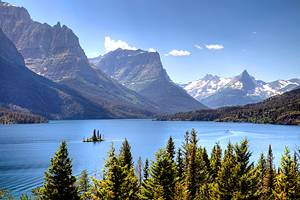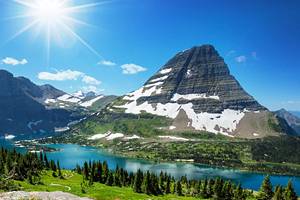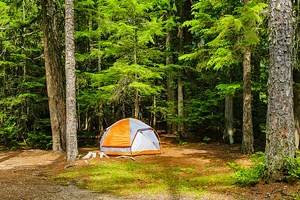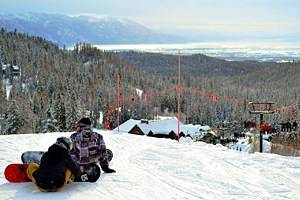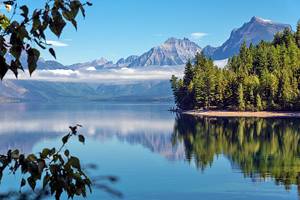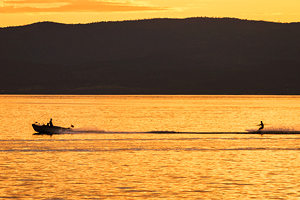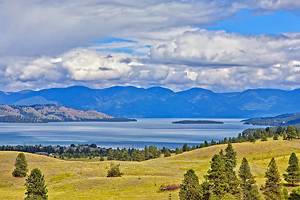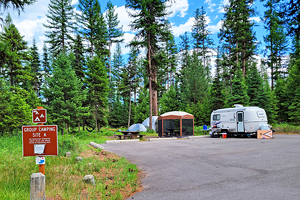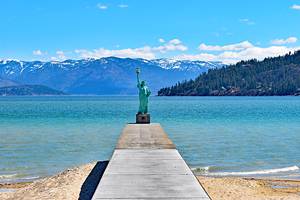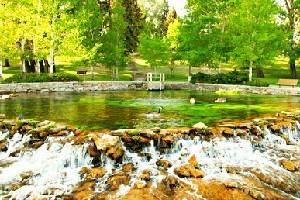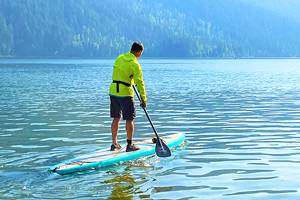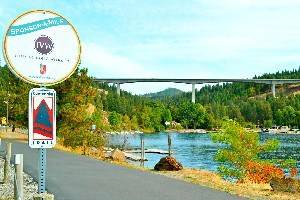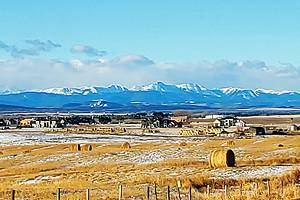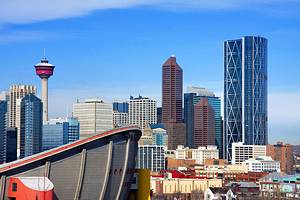Things to Do in Glacier National Park, MT
Author Brad Lane visited Glacier National Park many times while living in Missoula, Montana.
Glacier National Park in northern Montana is aptly nicknamed the Crown of the Continent. This vast expanse of beautiful natural space encompasses snow-crusted mountain peaks, deep glacial valleys, and shimmering alpine lakes bobbing with icebergs. And this crown jewel of the National Park Service, one of the top parks in the United States, draws over three million people each year — particularly during the peak season between July and September.
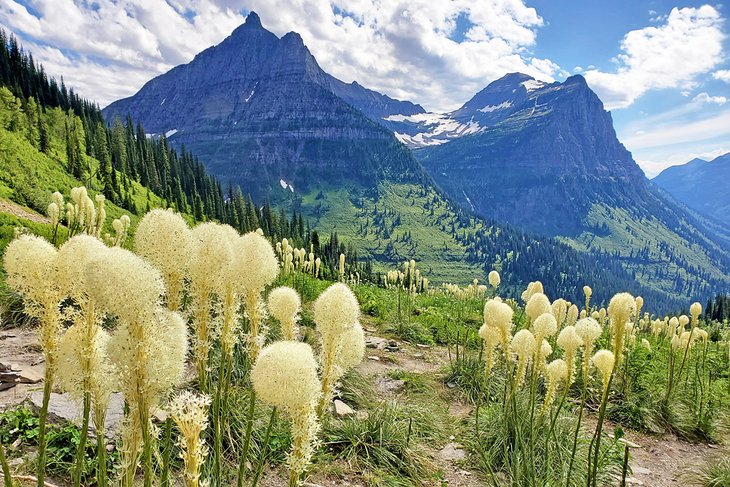
It helps to book as many days as possible when planning a Glacier National Park vacation. The park is home to over a million acres to explore, including over 700 miles of hiking trails. The main thoroughfare for many explorations is the 50-mile Going-to-the-Sun Road that spans the park from east to west. But like Two Medicine and Many Glacier, other areas of the park also deserve some attention.
Glacier represents a true choose-your-own-adventure when visiting. While day hiking is always popular, other popular recreation activities include boating, fishing, stargazing, bicycling, and taking guided excursions like the park's iconic Red Bus Tours. And several campgrounds and historic lodges within the park enable overnight visits.
Expect to encounter some wildlife when visiting Glacier. Common sightings include marmots, mountain goats, and bighorn sheep, as well as the occasional grizzly and black bear. The most prevalent wildlife species in summer, however, is the wandering tourist seen every mile along the Going-to-the-Sun Road. Planning ahead and making reservations helps you navigate the crowds that congregate seven days of the week.
Plan your next memorable Glacier getaway with our list of the top places to visit and things to do in Glacier National Park.
- Drive the Going-to-the-Sun Road
- Hang Out at Lake McDonald & Apgar Village
- Cross the Continental Divide at Logan Pass
- Tour the East Side and St. Mary Lake
- Go for a Day Hike
- Spend the Night at a Campground
- Stay at the Many Glacier Hotel or Lake McDonald Lodge
- White Water Rafting on the Flathead River
- Take a Guided Tour
- Visit the Many Glacier Region of the Park
- Explore Two Medicine
- Drive the North Fork Road to Bowman Lake
- Backpack into the Backcountry
- Ride a Bicycle on the Going-to-the-Sun Road
- Take a Family-Friendly Trek to Avalanche Lake
- Cross International Boundaries into Waterton Lakes National Park, Canada
- Cross-Country Skiing/Winter Activities
- Best Time to Visit Glacier National Park, MT
- Map of Things to Do in Glacier National Park, MT
Drive the Going-to-the-Sun Road
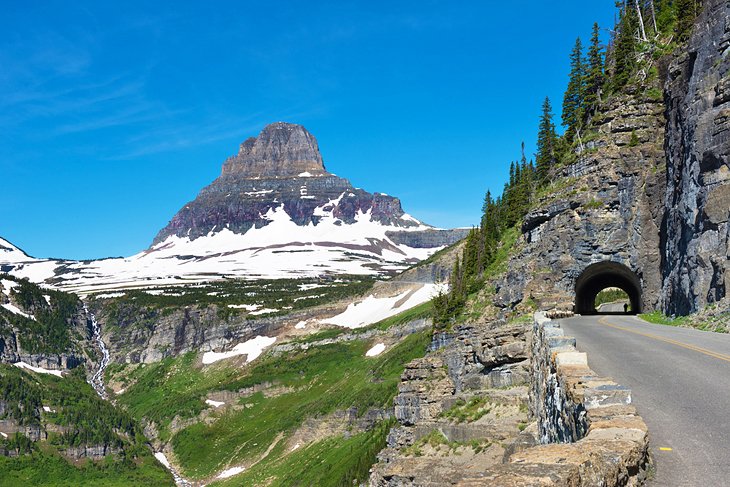
Highlights: The only road spanning the park summits the Continental Divide at Logan's Pass
The 50-mile Going-to-the-Sun is the only road that spans the interior of the park and is often a centerpiece of most visits. It connects Apgar Visitor Center on the west side of the park to the Saint Mary Visitor Center on the east. A third visitor center is located at the road's highest point at Logan Pass, where the route crests the Continental Divide.
Five of Glacier's 13 campgrounds are located along the Going-to-the-Sun Road. Numerous picnic areas, pull-offs, and trailheads also line the route. Besides its industrious engineering dating back to the 1930s, the road is also well known for its stunning views of enormous glacier valleys.
The park has recently instated a new Permit System for the Going-to-the-Sun Road, limiting the number of personal vehicles on the road between late May and early September. This time span is typically the only time when the route is snow-free. Permits are available 60 days in advance for each specific day throughout this summer season, and they sell out fast.
Alternative transportation options like the park's free shuttle system help alleviate logistics, like trying to find a coveted parking space at Logan Pass. The park also offers Red Bus Tours in the park's iconic 1930s "Rubies of the Rockies" open-top vehicles. And prior to opening for vehicle traffic in the spring, bicyclists have two weeks where they can ride the road vehicle-free.
Hang Out at Lake McDonald & Apgar Village
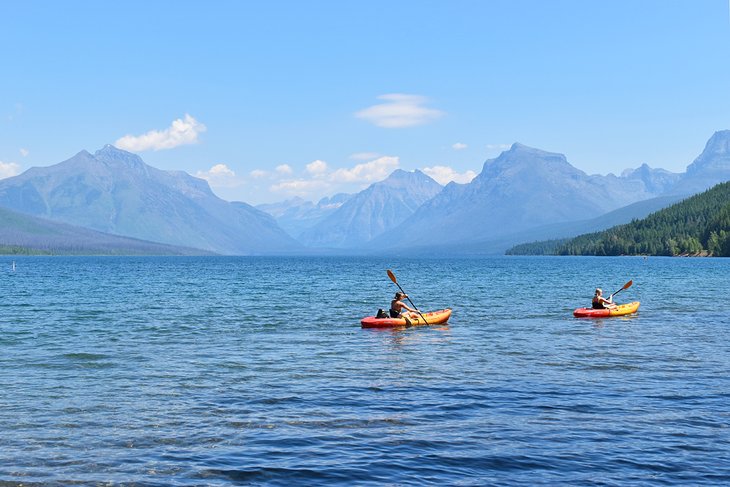
Highlights: Largest lake in Glacier and a major tourist attraction on the west side of the park
Lake McDonald is the largest body of water in Glacier and the center of activity on the west side of the park. It's often one of the first stops for visitors coming from West Glacier, with its southern shore less than two miles from the West Entrance, and it makes for quite the introduction.
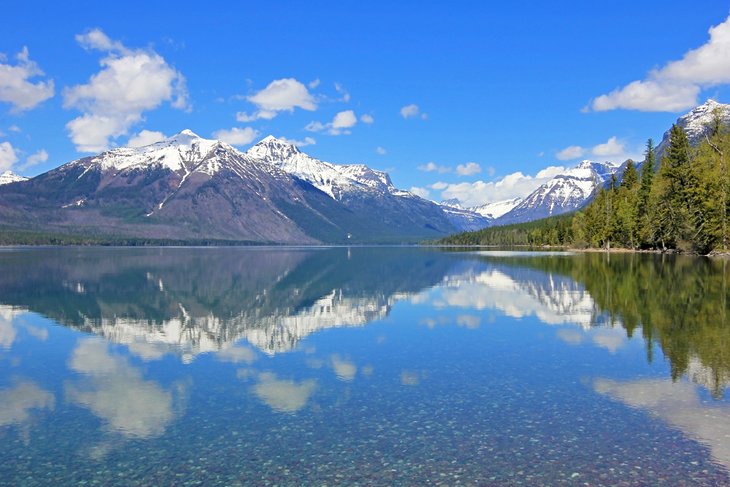
Four campgrounds are in this glacially carved region of the park, including Apgar Campground, with 194 sites available. Visitors here can also spend the night at the historic Lake McDonald Lodge, constructed in the 1910s on the banks of the water.
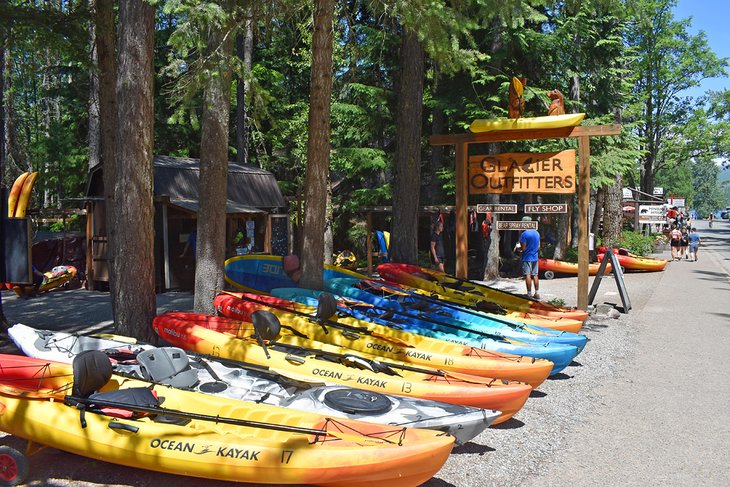
On the southwest shore, closest to the entrance station, Apgar Village has resources like a visitor center, general store, and a few casual restaurants. This area also has concessionaires offering non-motorized boat rentals and guided horseback rides. Lake McDonald Lodge, further up the eastern bank, has similar recreation purveyors.
Cross the Continental Divide at Logan Pass
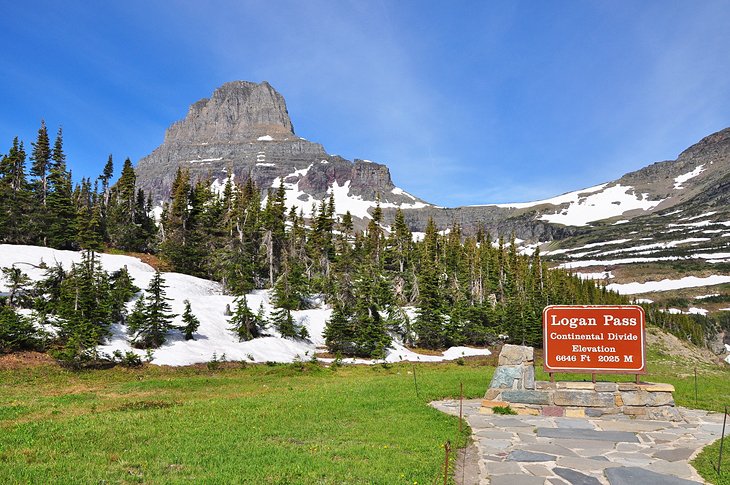
Highlights: Visitor Center, hiking trails, wildlife, and a busy parking lot
Logan Pass is the highest point accessible by vehicle in the park and sits at an elevation of 6,646 feet. It's a prominent stop and approximate halfway point on the Going-to-the-Sun Road. The ice-clad Clements and Reynolds Mountains backdrop this high-elevation postcard pitstop, and their meadows often abound with wildflowers. From here, you have a great snapshot of Glacier's grandeur.
Two of the most iconic hiking trails in Glacier start at the Logan Pass Visitor Center. The Highline Trail stretches from Logan Pass to the Granite Park Chalet, and the Hidden Lake Trail meanders through an area known as the Hanging Gardens before reaching a stunning overlook of its namesake feature.
Common wildlife sightings in the area include marmots, mountain goats, and the occasional grizzly bear. Logan Pass is also often strewn with Bear Grass, the park's signature flora, throughout the spring and summer. The Logan Pass Visitor Center is also atop the pass, offering excellent information about the surrounding landscape.
Parking is extremely competitive and scarce atop the pass. Throughout the summer, the parking lot often becomes full by 7am at the latest. The rest of the day involves cars endlessly circling the lot waiting for a spot to appear. Reserving a seat on the free Going-to-the-Sun Road shuttle to Logan Pass alleviates these parking headaches.
Tour the East Side and St. Mary Lake
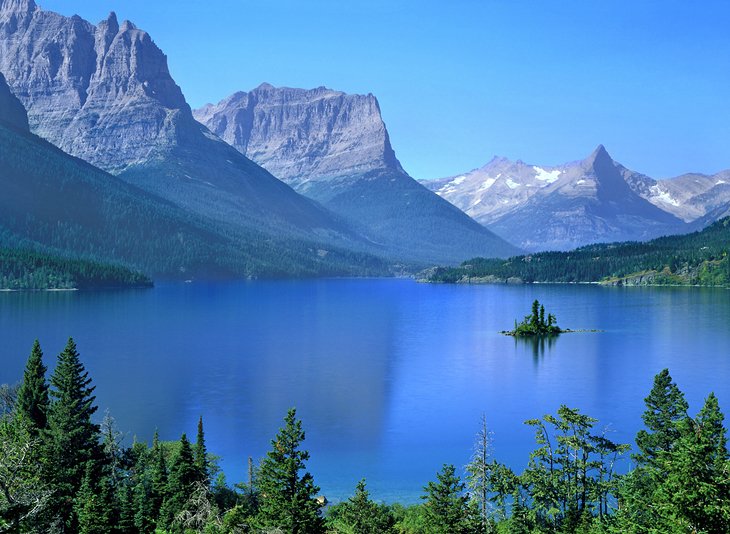
Highlights: Central location for hiking trails, campgrounds, and exploring the east side of the park
The 10-mile St. Mary Lake is the defining feature near the East Entrance of Glacier National Park.
The St. Mary Visitor Center is located near the far end of the lake and entrance station, where visitors can find information about the park and pick up the free Going-to-the-Sun Road shuttle. The St. Mary Campground is also located near the banks of the lake and is the second largest campground in Glacier, with 148 sites available.
The Going-to-the-Sun Road parallels the northern shore and offers spectacular vistas of the lake. One of the most photographed features is the tiny Wild Goose Island, seemingly floating in the middle of the water. Several pull-out areas along the banks also offer opportune spots for a picnic or lakeside lounge.
Hiking trails stemming from the St. Mary Valley include St. Mary Falls and Siyeh Pass from Sunrift Gorge. Additional camping near St. Mary Lake is located at the Rising Sun Campground, with lodging available at the Rising Sun Motor Inn.
Go for a Day Hike
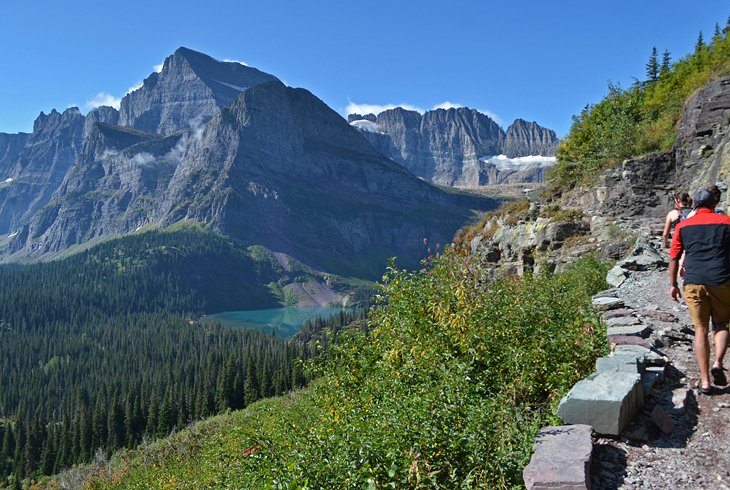
Highlights: Hundreds of miles of hiking trails catering to all skill levels
Glacier National Park has an astonishing 700-plus miles of trails stretching throughout the park. These designated footpaths lead to iconic landscapes like glistening glaciers, panoramic mountain passes, and iceberg-topped lakes. And for anyone who likes ambling down a trail, Glacier National Park offers a true kid-in-a-candy-shop mentality for hiking and backpacking.
A few signature hikes in Glacier National Park include the Highline Trail at Logan Pass and Grinnell Glacier in Many Glacier. A few less crowded options include Cobalt Lake and Siyeh Pass. With so much to explore, it would take a decade of summers to hike every route winding through the park.
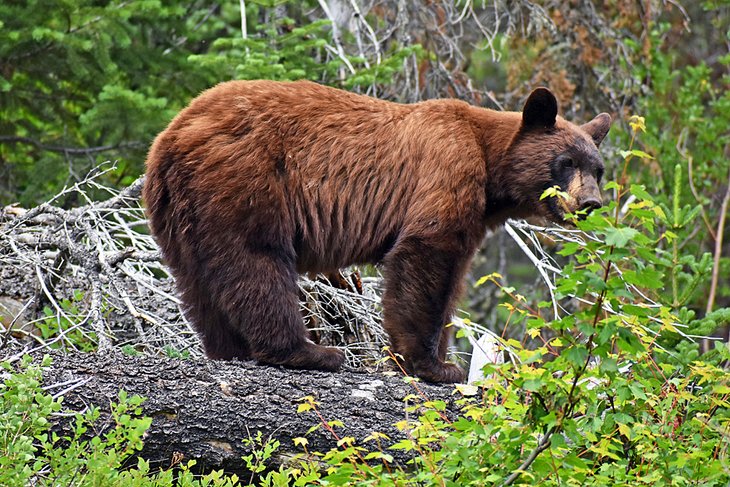
All hiking trails in Glacier National Park meander through grizzly bear country, and hikers should plan accordingly. Proper precautions include carrying bear spray, traveling in groups, and making plenty of noise while hiking. It's also critical for hikers to stay at least 100 yards away from the park's bigger mammals including bears and moose. Visit the park's page on bear safety for more information on safe travel.
Spend the Night at a Campground
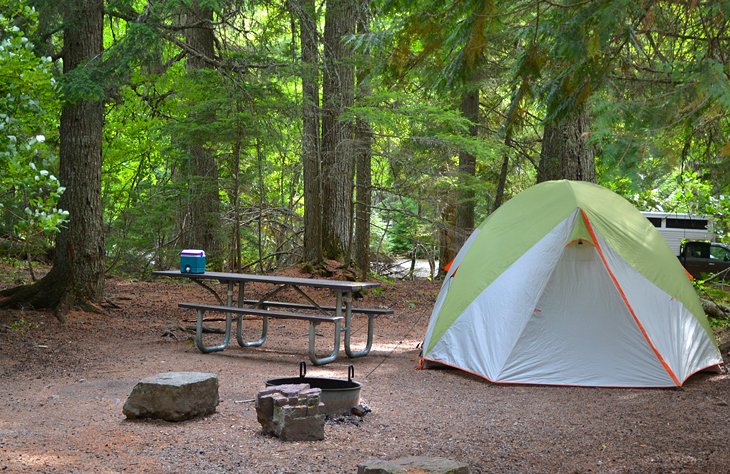
Highlights: Wide array of options to spend the night on both sides of the park
Given its slightly remote location in northern Montana, the best way to experience Glacier is by spending the night. Glacier has 13 campgrounds within park boundaries, and several private campgrounds are located near the park's different entrances – all comprising Glacier's best campgrounds.
The largest campground, Apgar Campground, is on the east side of the park and often fills to capacity by early morning throughout the summer. Saint Mary Campground, the largest on the east side of the park, also routinely fills to capacity and is one of the few campgrounds that accept advanced reservations.
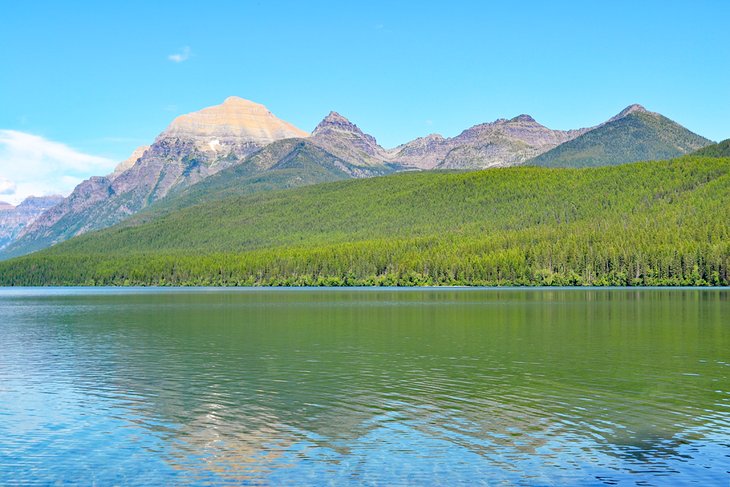
On the east side of the park, the Two Medicine and Many Glacier regions both have popular campgrounds connected to a variety of trails. For less crowded campgrounds in Glacier, more remote areas like Bowman Lake and primitive campgrounds including Cut Bank offer campsites that don't fill up nearly as fast.
Glacier National Park also maintains over 60 backcountry campsites available by permit only.
Stay at the Many Glacier Hotel or Lake McDonald Lodge
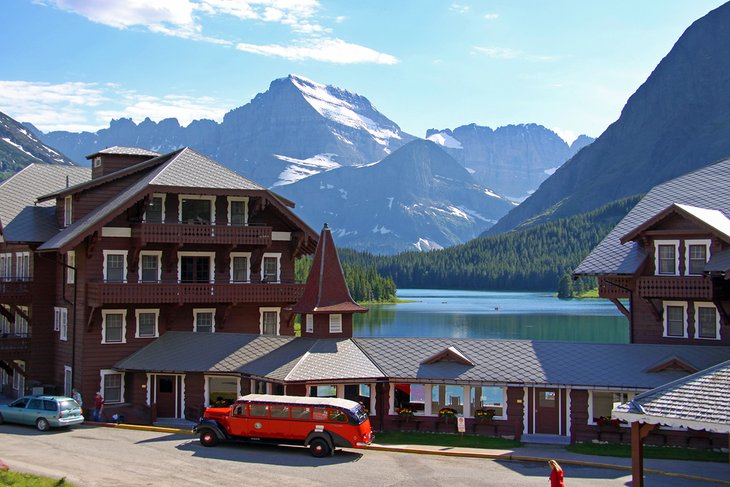
Highlights: Historic hotel on the banks of Swiftcurrent Lake
In the Many Glacier region of the park, the Many Glacier Hotel exudes a natural charm that is infused with the history of the park. It was first built in 1914 by the Great Northern Railway, and still today encompasses an iconic view of Mt. Grinnell from across Swiftcurrent Lake.
The hotel features a snack shop, dining room, and a unique Swiss-style lobby with a large billowing fireplace and rustic features. Keeping to Swiss-inspired traditions, many of the employees of the hotel are dressed in lederhosen. Reservations are required to stay at the hotel and are competitive to get.
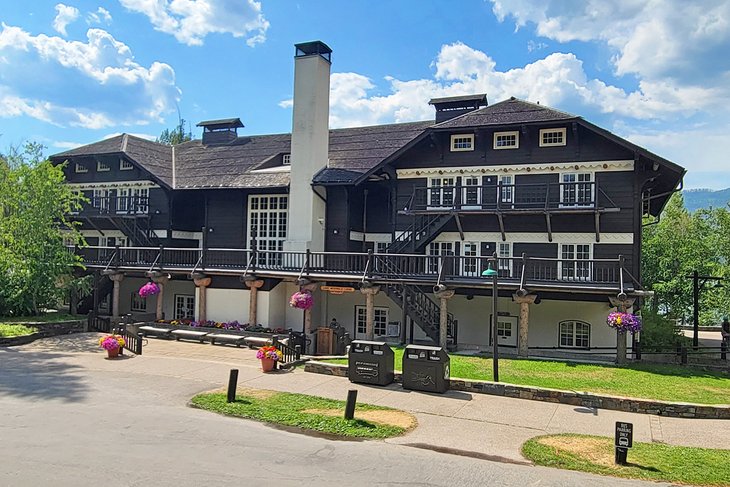
The Many Glacier Hotel isn't the only historic lodging within the park. On the west side, the Lake McDonald Lodge has also stood the test of time and has offered memorable stays for more than a century. Similar to Many Glacier Hotel, Lake McDonald Lodge offers modern accommodations within rustic settings. Televisions, air-conditioning, and elevators are not available.
White Water Rafting on the Flathead River
Highlights: World-class rapids on the Flathead River surrounding the park's southwest border
There's no white water rafting inside Glacier National Park, but several companies offer renowned adventures on the Flathead River, which defines the park's southern and western borders. These guided adventures occur on the Flathead River's Middle Fork and North Fork, with several companies offering half-day and full-day adventures.
Summer white water trips tend to book up fast on the Flathead River. Minimum age, height, and weight restrictions may apply.
Take a Guided Tour
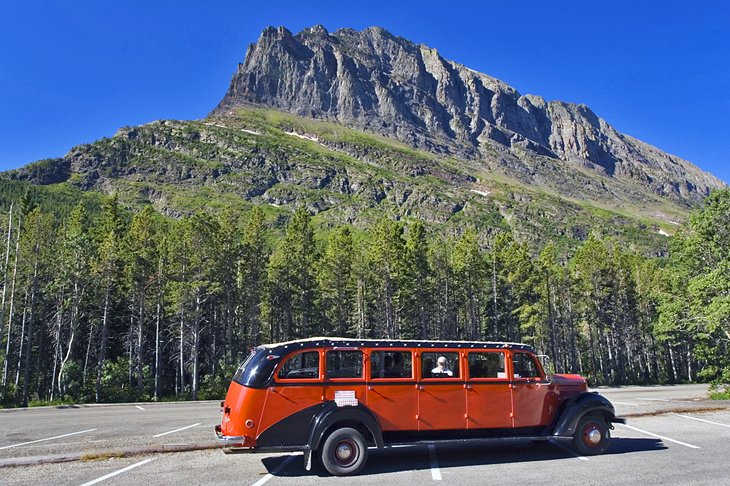
Highlights: Several guided trip opportunities, from group bus rides to horseback tours
Guided adventure opportunities can really enhance a Glacier National Park visit. From Red Bus Tours to hiking endeavors led by Glacier Guides, both the National Park Service and several private companies offer guided experiences. And many of the guided activities in Glacier book up months ahead of time.
Other popular guided activities include scenic boat ferries, horseback rides, and rafting trips on the Flathead River. Zipline courses are also available outside the western park boundaries. For more in-depth and extended guided experiences in Glacier, the private and non-profit Glacier Institute features experiential educational courses for adults, teens, and children.
Visit the Many Glacier Region of the Park

Highlights: Iconic destination that is not on the Going-to-the-Sun Road
The Many Glacier region of the park is on the east side of the Continental Divide and not accessible from the Going-to-the-Sun Road. It's still very much a popular place to visit, thanks to its status as a hot spot for hiking trails, wildlife sightings, and lodging opportunities.
The closest community to Many Glacier is Baab, with a gas station and general store approximately 13 miles away. Baab is nine miles north of the St. Mary Village and Entrance Station.
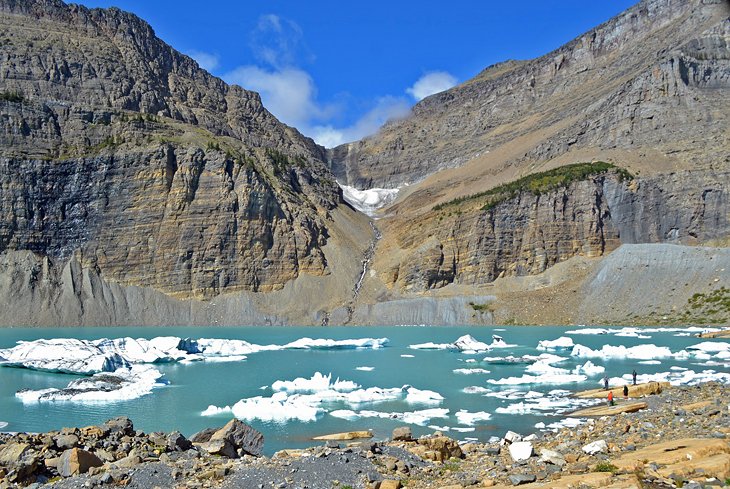
At the heart of Many Glacier, the Many Glacier Hotel overlooks Swiftcurrent Lake and a spectacular mountain scene. Boat rentals are located just below the hotel's generous patio. Other lodging options include the Swiftcurrent Inn and Many Glacier Campground. Some of the real highlights of the area, however, are hiking trails like Cracker Lake and Grinnell Glacier.
The round trip to Grinnell Glacier and back is just over 10 miles of hiking with over 1,600 feet of elevation gain. Visitors can cut down on those miles by taking a fee-based shuttle across Swiftcurrent Lake and Lake Josephine. Both approaches deliver massive mountain views and lush valley landscapes before you even set sight on Grinnell Glacier.
Explore Two Medicine
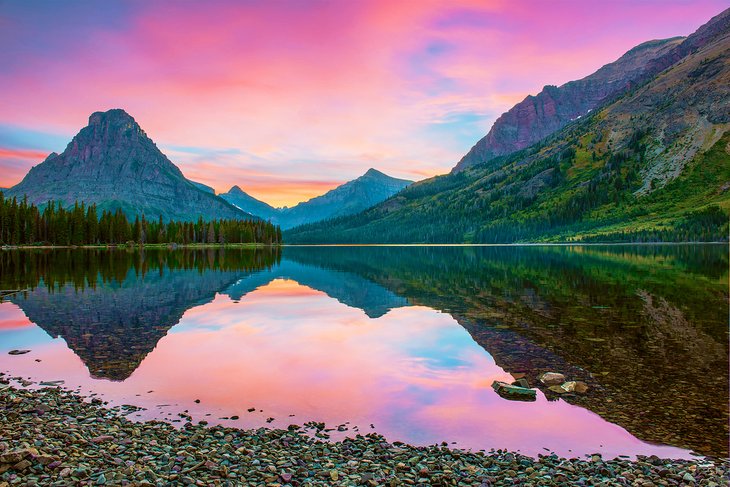
Highlights: Historic first-developed area of the park, now slightly less crowded than the rest
On the east side of the park, the Two Medicine region was once the main destination for early visitors to Glacier. After the Going-to-the-Sun Road was built, Two Medicine was no longer the central hub of activity, but all its mountain grandeur remained.
Two Medicine is now a less-crowded and slightly more off-the-beaten-path destination in the park, centered around the sparkling Two Medicine Lake. Though less popular than campgrounds like Apgar and St. Mary, the Two Medicine Campground also tends to fill up entirely during the peak summer season.

Several waterfalls are great outlets for adventure in Two Medicine, including the accessible Running Eagle Falls. Burlier hiking trails like Pitamakan and Dawson Pass offer elevated views of the Two Medicine region. Boat tours are also available that ferry visitors across Two Medicine Lake.
Drive the North Fork Road to Bowman Lake
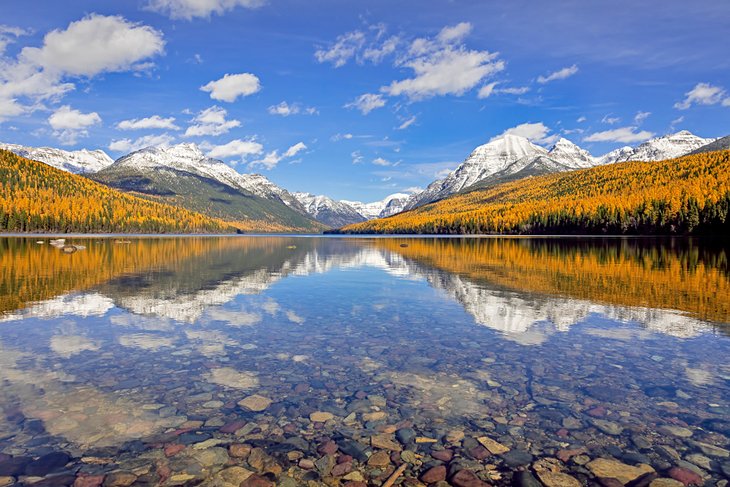
Highlights: Far-flung and less-crowded northwest corner of the park, home to Polebridge Mercantile
In the far northwest corner of Glacier, accessible only by a winding gravel road, Bowman Lake is part of the less-visited North Fork region of the park. Plenty of people with proper vehicle clearance still visit Bowman Lake and the adjacent campground throughout the summer, though the congestion is nothing like you find on the Going-to-the-Sun Road.
The gravel North Fork Road follows the North Fork of the Flathead River, a popular rafting waterway that denotes the western boundary of the park. The road also leads to Kintla Lake, a few miles farther north of Bowman Lake.
The only available resources in this part of the park are found in the small and eclectic community of Polebridge. Within this tiny community, the Polebridge Mercantile & Bakery is an iconic place to visit that has been outfitting visitors for over 100 years. Souvenirs, gear rentals, and fresh-baked confections are available at "The Merc."
Backpack into the Backcountry
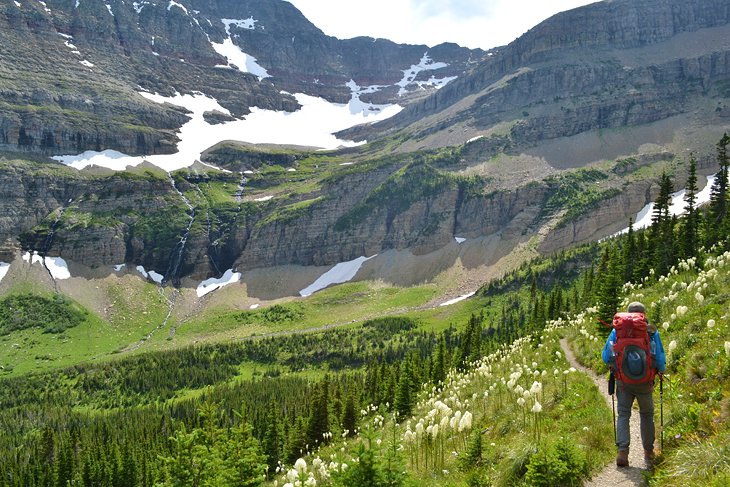
Highlights: Deep wilderness infused with waterfalls, camping zones, and wildlife
One of the best ways to experience Glacier is via the extensive network of backcountry trails that navigate the interior of the park. Anyone interested in enjoying Glacier's backcountry needs a permit to spend the night, which can be obtained through a lottery reservation system that opens in March, or through a limited walk-up availability during the season.
Glacier's landscape is demanding but very rewarding, with a few highlighted backcountry destinations including Stoney Indian Pass, the Ptarmigan Tunnel, and Hole-in-the-Wall. Several route options are available, ranging from one-night trips to week-long expeditions through the heart of the park.
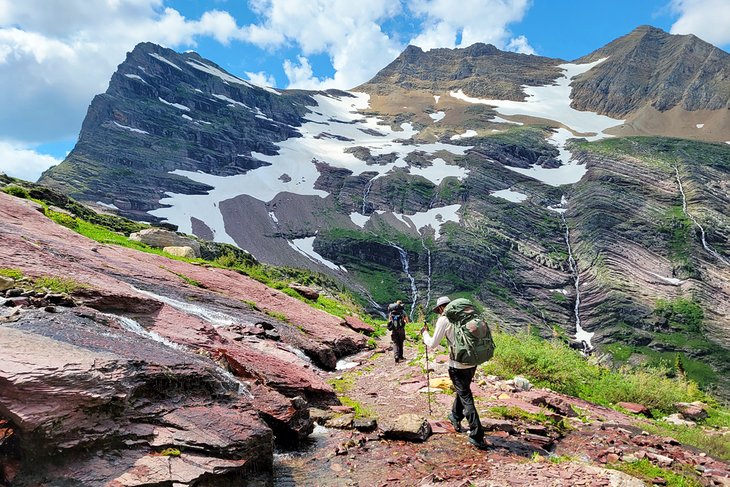
Obtaining a walk-up backcountry permit is done by showing up to one of several backcountry permit offices in the park on the day of or the day before a desired trip. Bring a few possible itineraries to the office, and a ranger will work with what campsites are available to create a route. Visit the park's Wilderness Camping page for more information.
Ride a Bicycle on the Going-to-the-Sun Road
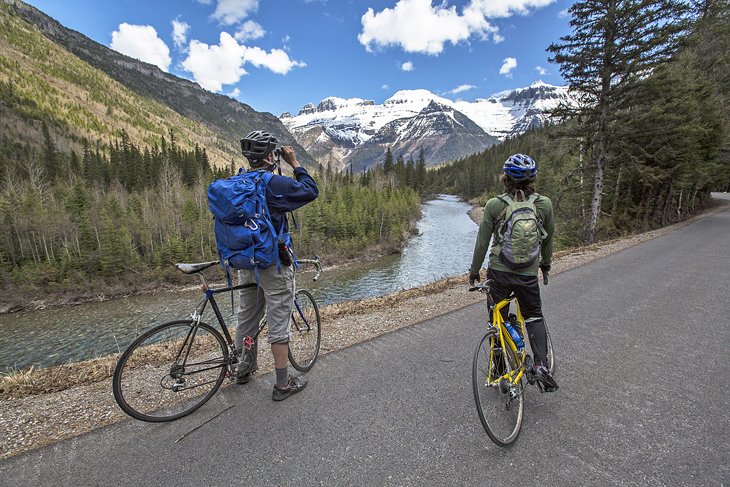
Highlights: Opportunities to bicycle the Going-to-the-Sun Road while it's vehicle-free
The best time to bicycle the Going-to-the-Sun Road is in the spring when plows have started to move snow and before the road officially opens to vehicles. Once the Going-to-the-Sun Road opens to vehicle traffic, cyclists can still travel the entire road until June 15th.
Caution and good riding practices, including highly visible clothing and gear, need to apply when bicycling the Going-to-the-Sun Road alongside vehicles.
The exact dates and distances that cyclists can travel vehicle-free on the Sun Road is weather dependent, and cyclists aren't allowed anywhere near where plow crews are working. Glacier National Park's Road Status page keeps up-to-date information regarding opening dates for the Going-to-the-Sun Road.
Between June 15th and Labor Day, certain sections on the east side of the Going-to-the-Sun Road prohibit bicycling for congestion issues. Mountain biking and trail riding are not allowed in Glacier National Park.
Take a Family-Friendly Trek to Avalanche Lake
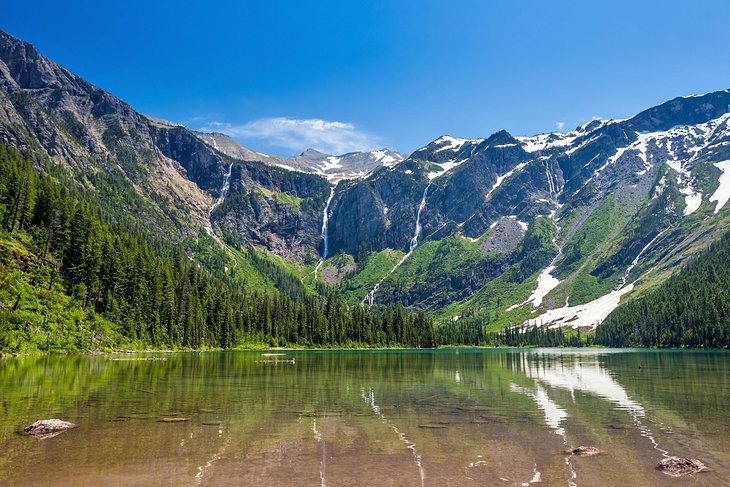
Highlight: Popular family hiking destination on the east side of the park
Avalanche Lake is one of the most popular short hikes in Glacier, and it's a great choice for those traveling with first-time hikers.
Its trailhead is near the banks of Lake McDonald on the east side of the park. Alongside the shimmering spectacle of Avalanche Lake, the trailhead also lends access to the less-than-a-mile and family-favorite Trail of the Cedars.
The 2.3-mile trail first traverses alongside the deeply carved banks of Avalanche Creek and through a lush forest before reaching the glacial waters of Avalanche Lake. Here, several spaces spread across the lakeshore, catering to the large crowds that tend to gather throughout the summer. The trail, itself, is also wide and accommodating for two-way traffic.
Cross International Boundaries into Waterton Lakes National Park, Canada
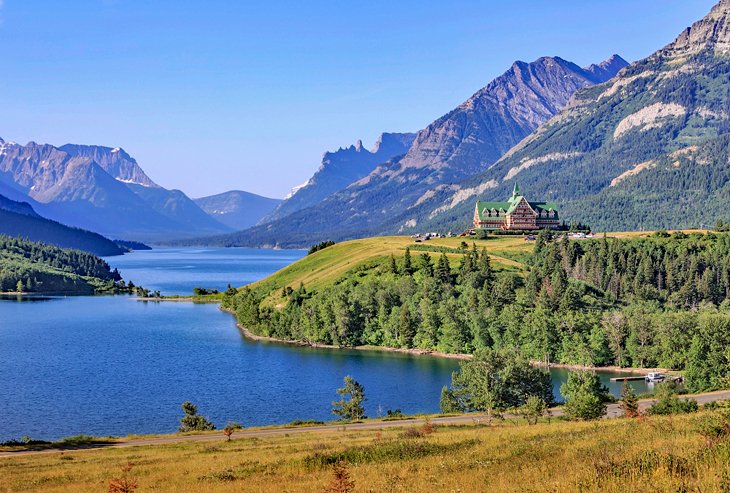
Highlights: Entire second national park just across international borders
Making up the second half of the Waterton-Glacier International Peace Park, Alberta's Waterton Lakes National Park is located directly across the border from the Goat Haunt region of Glacier. The immensity of Glacier National Park extends well into Canada, and Waterton Lakes provides arguably even bigger terrain to explore.
Popular things to do in Waterton Lakes National Park include exploring Red Rock Canyon, visiting Waterton Village, and hiking the 200 kilometers of hiking trails, including the iconic Crypt Lake Trail. For those looking to cross international borders, expect to have to show your passport at border crossings.
Cross-Country Skiing/Winter Activities
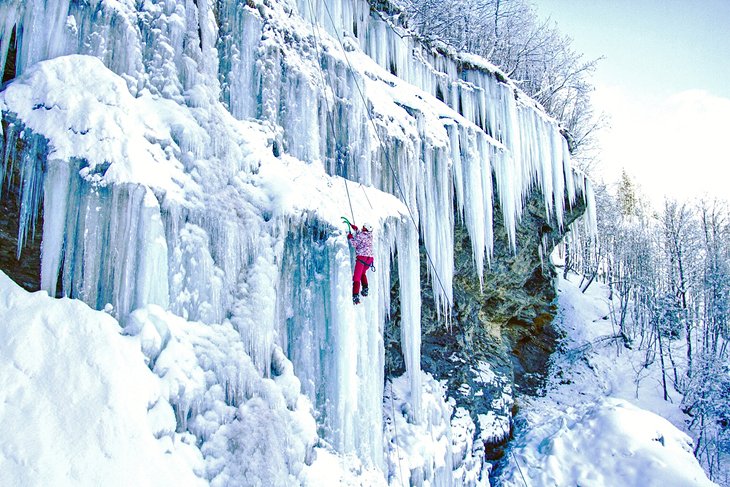
Highlights: Cross-country ski trails near the park's entrances for winter visits
The least crowded time to visit Glacier is during the winter. Networks of trails are available for skiing and snowshoeing near the east and west entrances at St. Mary and Apgar. It's important to check trail conditions before heading to Glacier for winter activities, as well as local forecast conditions.
Avalanche danger is real in Glacier, and anyone looking to cross the park's backcountry in winter needs to obtain a permit and understand the risk. Traveling this time of year can be more difficult, and visitors should be comfortable with winter conditions before making the journey.
Best Time to Visit Glacier National Park, MT
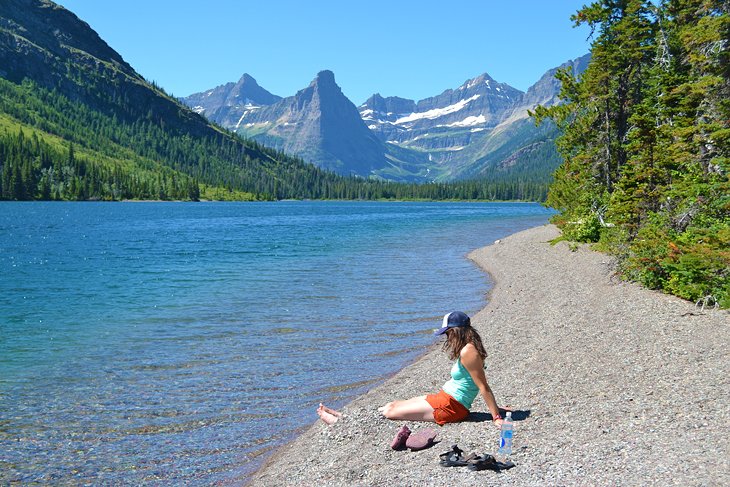
For a vast majority of visitors, the best time to visit Glacier National Park is during the summer season between mid-June and late September. The months of July and August in particular are a great time to visit. The iconic Going-to-the-Sun Road that spans the entire park is snow-free during these summer months, and other high-mountain hiking trails are accessible throughout the season. The summer season does come with some crowds, but there's plenty of scenery to share in the 1,500-square-mile national park.
Each season also brings its own challenges, like crowds in the summer and variable road conditions throughout the rest of the year. With the right preparation and planning, though, every season in Glacier offers reasons to visit.
Spring: Spring in Glacier typically begins in May and extends through mid-June and early July in the highest regions of the park. Alongside fewer crowds to contend with, wildflowers start to give Glacier some color later in the season, and many of the park's waterfalls are at their highest flow during the spring. Wildlife in the park also tends to become more active as things start to warm up.
Spring is a good time to visit for fewer crowds, but many facilities, including the Going-to-the-Sun Road, don't open until late June at the earliest. Campgrounds and other facilities like restaurants and lodging also don't generally open until Memorial Day Weekend.
Summer (Best Time to Visit): Glacier National Park is in full operation during the summer, particularly in July and August. Summer is the peak visiting season in Glacier. Popular activities in the summer include camping, backpacking, day hiking, fishing, and boating. Cooler temperatures in the evening also allow guests to enjoy Glacier's starry night sky. The free Going-to-the-Sun Road shuttle operates on a full-time schedule in the summer.
Fall: Fall brings variable weather throughout the region, but Glacier National Park in September is a particularly good time to visit. Crowds typically diminish after Labor Day, and daytime highs stick around the 60s and 50s throughout the season. Autumn is quite colorful in Glacier, particularly between late September and mid-October when golden larches dot the mountainsides. Many of the park's iconic hiking trails also have fewer crowds this time of year.
Several of the park's facilities close during the fall, with resources like lodging and restaurants becoming less available throughout the season. Many campgrounds within the park also close in September, except St. Mary and Apgar Campground, which operate year-round. The Going-to-the-Sun Road typically becomes impassable by the third Monday in October.
Winter: Encompassing both sides of the Continental Divide, winter weather in Glacier National Park is variable from one region to the other. Glacier in November and December features road closures, avalanche conditions, and cold temperatures throughout the park. Despite the difficulties, winter in Glacier has many rewards that make it worth a visit.
While few facilities are open within the park during the winter, the surrounding communities are often happy to host visitors with reduced overnight rates. Free winter camping in Glacier is available at the St. Mary Campground and Apgar Campground for those equipped to handle the conditions. Popular activities for winter visitors include cross-country skiing and snowshoeing.
Map of Things to Do in Glacier National Park, MT
More Related Articles on PlanetWare.com
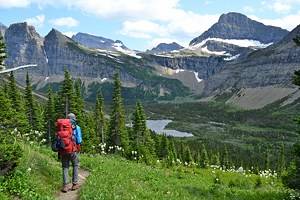
More to Explore in Glacier National Park: Leading to iconic spots like Iceberg Lake, Ptarmigan Tunnel, and Grinnell Glacier, the best hiking trails in Glacier National Park highlight what makes Glacier an international destination. For additional information on the 13 campgrounds within Glacier National Park, as well as additional places to pitch a tent or park an RV outside of the park boundaries, our guide to the best campgrounds in Glacier National Park has all the details you need.
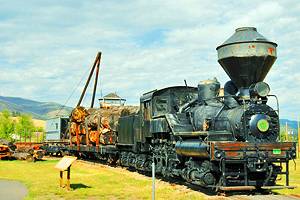
Best Montana Cities to Discover: The mountain town of Whitefish is right at the front door of Glacier National Park and lends access to other attractions and stunning places to visit, including Flathead Lake and the Kootenai National Forest. Approximately three hours from Glacier National Park, the university city of Missoula offers even more outdoor appeal with nearby trailheads in the Bitterroot National Forest and Rattlesnake National Recreation Area. Offering more collegiate appeal and nearby mountains to explore, Bozeman is booming in popularity and is near the northern entrance of Yellowstone National Park.


